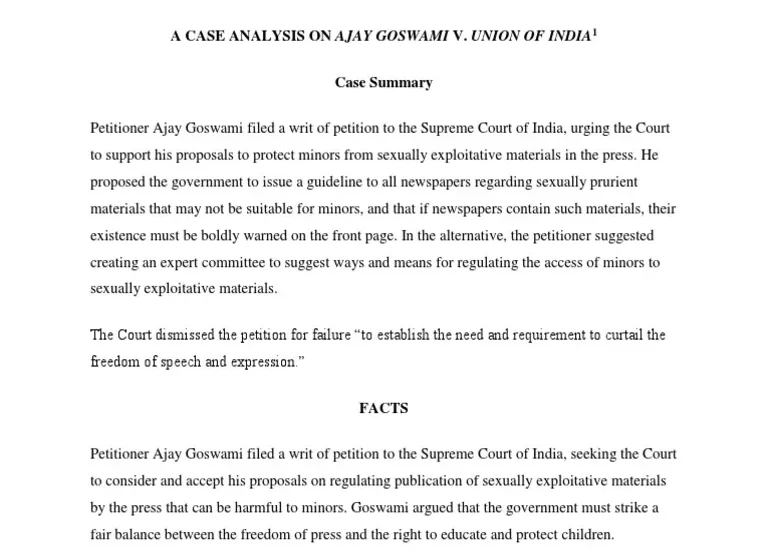In 2006, Ajay Goswami filed a writ petition with the Supreme Court of India. He laid out the concern for the protection of minors from sexually explicit content in newspapers. The argument proposed by him was that the government should create guidelines for newspapers. This should be done to prevent minors from accessing such materials. More importantly, he proposed that if newspapers included sexually explicit content, they should provide a warning. This could be provided on the front page. However, his plea was rejected by the Court on December 12, 2006. Continue reading to learn all about the case of Ajay Goswami VS Union of India.
Ajay Goswami vs Union of India Case Arguments by the Petitioner
Goswami believed that there should be a balance between the freedom of the press and the protection of children. He claimed that exposing minors to sexually explicit content could harm their overall health. He cited specific articles from the newspaper, Times of India, such as “Porn in Potter VI”. Here, he argued that even if minors do not read the newspapers, reading such headlines could draw them into finding out what the content is. This could propagate further inappropriate thoughts in their mind.
Moreover, his argument further stated that under Article 21 of the Constitution. The Article guarantees the right to live, there is also the right to education. This right encompasses the right to appropriate education. In his defense, he stated that the appropriate education should be determined by teachers and parents. Therefore, he stated that newspapers should not indiscriminately publish such content. They should consider the repercussions on the children.
Along with this, he also proposed a few measures. These included suggestions such as, the government should issue detailed guidelines for newspapers. This is regarding content unsuitable for minors. Secondly, newspapers should implement a self-regulatory system based on these guidelines. If newspapers publish any content deemed inappropriate, they should package it differently. They should prominently warn readers on the front page too. This approach would allow parents to decide whether to allow children to access such newspapers. Alternatively, he also suggested that the government form an expert committee. This should be to study how to regulate minors’ access to sexually explicit materials.
Also read: Kuldeep Kumar vs UT Chandigarh: Supreme Court Justice in Mayoral Election
Decision of the Supreme Court in Ajay Goswami vs Union of India Case
The Supreme Court, led by Justice Lakshmanan reviewed Goswami’s proposals. Firstly, the court examined existing laws governing the press and the protection of minors. It was noted that there are already regulations in place, including the Press Council Act of 1978 and Section 292 of the Indian Penal Code.
The Press Council Act establishes a body to ensure that the newspapers maintain high standards and respect their responsibilities. Under this Act, the Council can receive complaints about published materials. It also requires newspapers to publish corrections and warnings as needed. Along with this, Section 292 of the Indian Penal Code, then prohibits the sale and distribution of obscene materials. Here, obscenity is defined as content that is lascivious or appeals to prurient interests. It considers the overall impact of the material on the readers.
The Court maintained the importance of free speech in the country. However, it also maintained that there might be instances where public order might necessitate some restrictions. However, it focused on the fact that any limitation set on speech must be reasonable.
Views on Media
More importantly, the Court looked into the broader context of obscenity in the media. Referring to one U.S Supreme Court case titled, Reno v. American Civil Liberties Union, it laid out the following observations. Firstly, under this case, the ruling was against overly broad restrictions on speech aimed at protecting children. The U.S. court found that protecting children does not imply suppressing speech intended for adults.
When stating its analysis, the Supreme Court observed that publications should be judged as a whole. It emphasized that not every mention of sex or nudity is obscene. It focused on the fact that a blanket ban on certain content could lead to newspapers catering only to children. Curtailing this content could also mean depriving adults of other content.
The Court concluded that the newspapers mentioned by Goswami did not intend to harm minors. They did not cater to any prurient interests. Noticing that existing regulatory measures are sufficient, the court stated that the case could be dismissed. This was done since these measures prevent the publication of objectionable materials.
Explore the landmark case of Ajay Goswami vs Union of India, which addresses freedom of speech and the balance with public decency. Learn the legal insights and verdict.
Explore the landmark case of Ajay Goswami vs Union of India, which addresses freedom of speech and the balance with public decency. Learn the legal insights and verdict.
Also read: Emergency Provisions in Indian Constitution: Types, Causes & After Effects
Conclusion
Finally, the Court dismissed Ajay Goswami’s petition on the terms that it failed to demonstrate a need to restrict freedom of speech and oppression. It upheld the importance of existing laws and regulations. Also, it recognized a balanced solution to protect minors as well as not curb freedom of speech.
